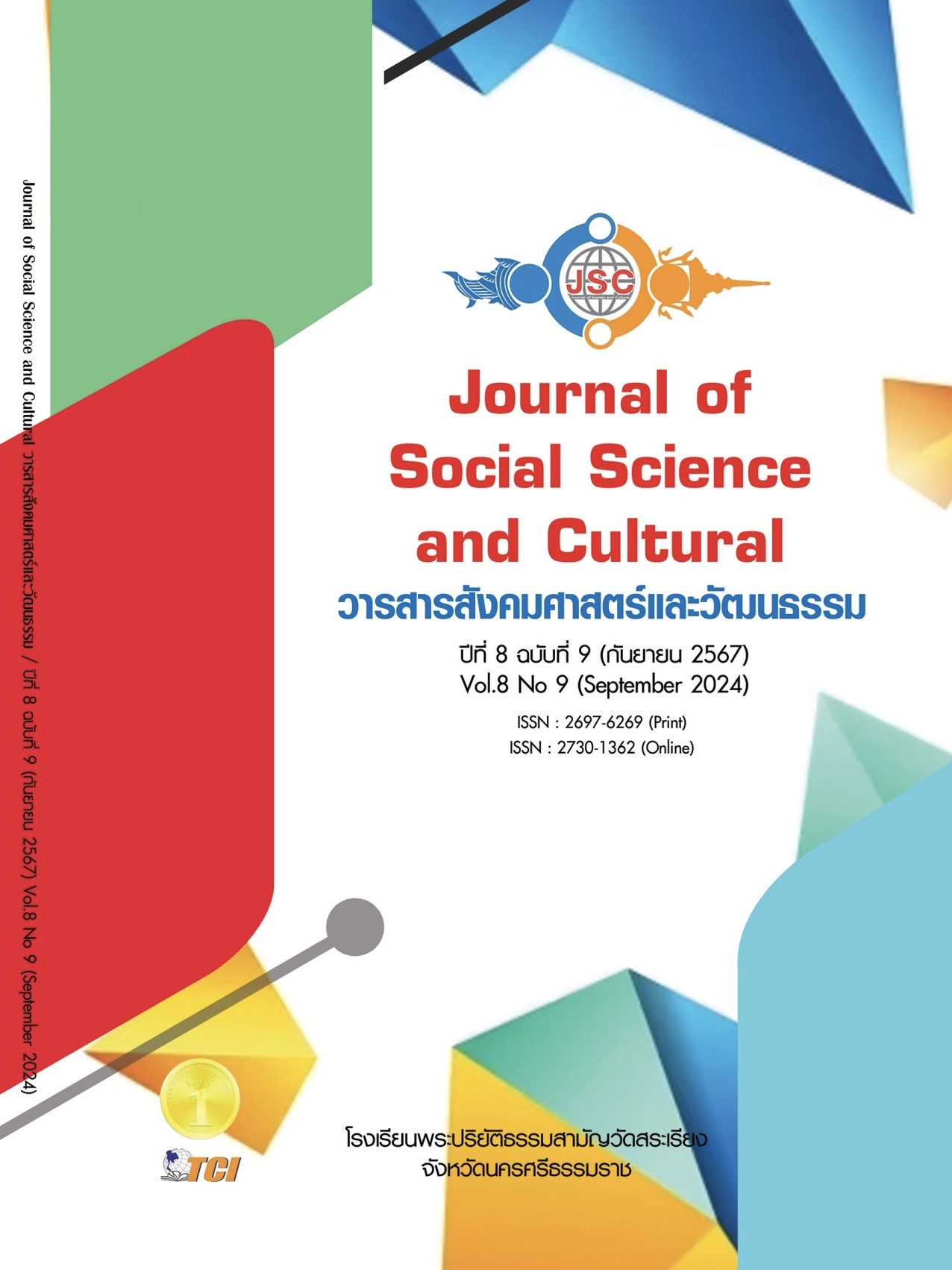DEVELOPMENT GUIDELINE OF FACILITIES MANAGEMENT FOR SENIOR TOURISTS IN THAILAND'S RIVIERA HOTELS
Main Article Content
Abstract
This research aims to 1) study the development guidelines of facilities management for senior tourists in Thailand Riviera hotels (also known as Thailand Western Seaboard Tourism Development Regions Hotels) , which are located in the provinces of Phetchaburi, Prachuap Khiri Khan, Chumphon, and Ranong respectively. The result of study could be a guideline for hotel in order to provide an appropriate facility management for senior tourists. The research methodology used here is quantitative. 400 senior tourists, both Thais and foreigners, who had previously stayed in the Thailand Riviera regions and were 60 years of age and above, made up the sample group. A five - points Likert scale was used as the research instrument. The statistics used for data analysis were percentage, mean, standard deviation, and Structural Equation Model (SEM) analysis. According to the general data collected, the majority respondents were senior female tourists, between the ages of 65 - 69, with a bachelor’s degree, married status, originating from a European country, and monthly incomes ranging between 55,001 - 65,000Thai baht. The research findings, in accordance with the objectives, reveals that the following crucial elements must be taken into consideration when developing guidelines for facility management for senior tourists in the study area of: 1) Service quality component, 2) Universal Design component and 3) Thailand Hotel and resort standards components. This is to enable hotel entrepreneurs, hotel front line employees, government and relevant departments to use these guidelines for facility management within hotel in order to serve senior tourists properly.
Article Details
References
กรมกิจการผู้สูงอายุ. (2566). สถิติข้อมูลผู้สูงอายุชาวไทย ประจำปี 2565. เรียกใช้เมื่อ 14 สิงหาคม 2566 จาก https://www.dop.go.th/th/know/side/1/1/1159
กระทรวงการท่องเที่ยวและกีฬา. (2567). แผนพัฒนาการท่องเที่ยวแห่งชาติ ฉบับที่ 3 (พ.ศ. 2566 - 2570). เรียกใช้เมื่อ 15 สิงหาคม 2567 จาก https://secretary.mots.go.th/more_news.php?cid=60
คณะกรรมการเศรษฐกิจและสังคมแห่งเอเชียและแปซิฟิก. (2560). Aging in the Asia and The Pacific Overview. เรียกใช้เมื่อ 6 มกราคม 2566 จาก https://www.unescap.org/sites/default/files/SDD%20Ageing%20Fact%20Sheet%20Overview.pdf
ชฎิล มาตรา. (2562). นวัตกรรมการบริการของโรงแรมเพื่อรองรับนักท่องเที่ยวผู้สูงอายุที่มาพักแรมในจังหวัดขอนแก่น. ใน รายงานการวิจัย. มหาวิทยาลัยศรีปทุม.
ไตรรัตน์ จารุทัศน์. (2558). Universal Design Guide Book: คู่มือการออกแบบเพื่อทุกคน: หน่วยปฏิบัติการวิจัยสภาพแวดล้อมที่เหมาะสมกับผู้สูงอายุและคนพิการ. (พิมพ์ครั้งที่ 2). กรุงเทพมหานคร: จุฬาลงกรณ์มหาวิทยาลัย.
สมาคมโรงแรมไทย. (2566). โรงแรมที่จดทะเบียนและได้รับการรับรองมาตรฐานที่พักเพื่อการท่องเที่ยวโดยสมาคมโรงแรมไทย (THA) ปี 2023. เรียกใช้เมื่อ 9 มกราคม 2566 จาก https://www.thaihotels.org/
สำนักข่าวสาลิกา. (2567). แชร์ไอเดียพัฒนาการท่องเที่ยวให้พร้อมสำหรับ "นักท่องเที่ยวสูงวัย" หัวใจพร้อมลุย. เรียกใช้เมื่อ 8 กันยายน 2567 จาก https://www.salika.co/2022/09/18/idea-for-aging-society-tourism
สำนักงานสถิติแห่งชาติ. (2567). สถิตินักท่องเที่ยวชาวต่างชาติที่เข้ามาประเทศไทย. เรียกใช้เมื่อ 8 กันยายน 2567 จาก https://ittdashboard.nso.go.th/preview.php?id_project=85
สิริกานต์ ทองพูน. (2564). ความพึงพอใจที่มีต่อสิ่งอ้านวยความสะดวกในโรงแรมของนักท่องเที่ยวสูงอายุ กรณีศึกษาโรงแรมในอำเภอเมือง จังหวัดเชียงใหม่. วารสารสุขศึกษา พลศึกษา และสันทนาการ, 47(1), 268-277.
เสาวรัตน์ บุษรานนท์ และสุดารัตน์ สุดสมบูรณ์. (2561). แนวทางการพัฒนาโรงแรมสำหรับนักท่องเที่ยว ผู้สูงอายุ. วารสารเทคโนโลยีภาคใต้, 11(2), 229-234.
Cochran, W. G. (1977). Sampling Techniques. (3rd Edition), New York: John Wiley & Sons.
Hair, J. F. et al. (2010). Multivariate data analysis: A global perspectives. Upper Saddle River. New Jersey: Pearson Education, International.
Kamran, S. (2013). Heuristics for Sample Size Determination in Multivariate Statistical Techniques. World Applied Sciences Journal, 27(2), 285-287.
Loehlin, J. C. (1992). Latent Variable Models: An introduction to factor, path and structural analysis. (2nd Ed), New Jersey: Hillsdale.
Losada, N. et al. (2017). Senior Tourist’s Accommodation Choices. International Journal of Hospitality Management, 66(2017), 24-34.
Mace, R. L. (1985). “Universal design, barrier-free environments for everyone.”. Los Angeles: Designers West, 33(1), 147-152.
Meltem, C. et al. (2013). Does the importance of hotel attributes differ for senior tourists? A comparison of three markets. International Journal of Contemporary Hospitality Management, 26(4), 610-628.
Parasuraman, A. et al. (1988). SERVQUAL: A multiple-item scale for measuring consumer perceptions of service quality. Journal of Retailing, 64(1), 12-40.
Rovinelli, R. J. & Hambleton, R. K. (1977). On the use of content specialists in the assessment of criterion-referenced test item validity. Tijdschrift voor Onderwijsresearch, 2(2), 49-60.
Thanasit, S. (2020). Service Quality Improvement for Senior Tourists at Hotels and Resorts in the Perception of Service Providers: Nakhon Ratchasima, Thailand. The EUrASEANs: journal on global socio-economic dynamics, 6(25), 56-61.
Wanxia, Y. & Onanong, C. (2022). The Evaluation of Tourism Services Quality for the Senior Tourists in Xishuangbanna China: An Investigation Using the SERVPERF Model. Science, Technology, and Social Sciences Procedia, 2022(2), 3-26.


